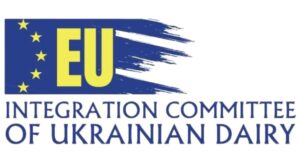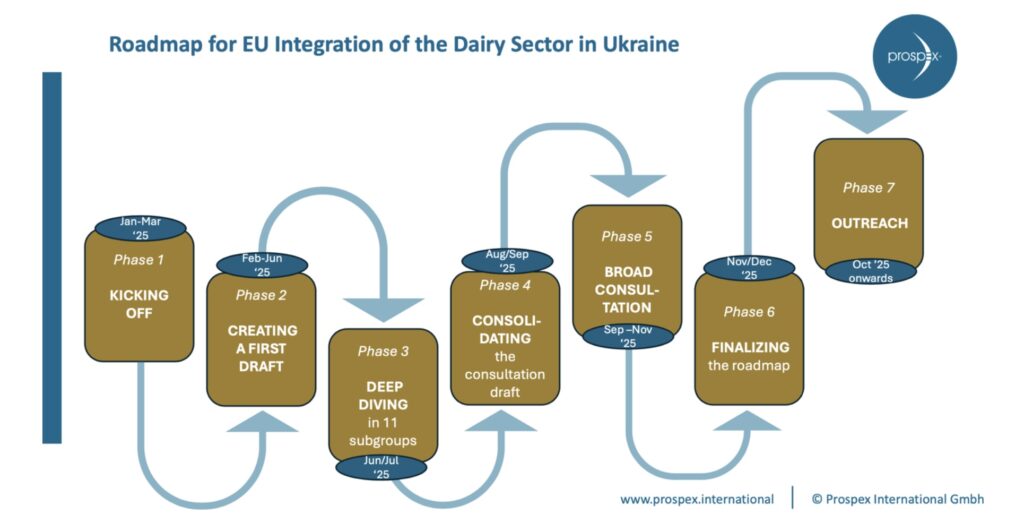 Why Does Ukraine’s Dairy Sector Need an EU Integration Roadmap?
Why Does Ukraine’s Dairy Sector Need an EU Integration Roadmap?
Ukrainian dairy producers have long been oriented toward European markets, as cooperation with the EU opens up new opportunities for industry growth.
That is why the Ukrainian dairy business community has initiated the development of an EU Integration Roadmap. This initiative is a crucial step toward further economic growth and the competitiveness of Ukrainian dairy products. The Roadmap is not just a formality in the negotiation process but an essential tool for the sustainable development of the dairy sector.
On February 27, an introductory meeting took place, where stakeholders from the private and public sectors, as well as EU representatives, had the opportunity to discuss the importance and stages of developing Roadmap for EU Integration of the Dairy Sector of Ukraine.
Why Is This Important for Ukraine’s Dairy Sector?
Despite ongoing military actions, Ukraine’s dairy industry is recovering, and adaptation to European standards continues. Andriy Tabalov, CEO of Voloshkove Pole dairy company and Chairman of the European Integration Committee of the Union of Dairy Enterprises of Ukraine (SMPU), emphasized the need for stronger ties with the European market: “Russia’s armed aggression against Ukraine has made everything crystal clear. Our path is with the EU because we share common values and business strategies. We are not competitors to European dairy producers; on the contrary, we strengthen the European dairy sector. Ukraine must take its rightful place in the European community. However, integration is a complex process. We face challenges, including high-quality raw material requirements and technical infrastructure improvements. This is a difficult task, especially during wartime, when attracting investment is a real challenge,” he stated.
According to him, deeper integration of Ukraine’s dairy sector into the European market will benefit not only Ukraine but also the EU, as Ukraine can be considered a key player in ensuring Europe’s food security.
Hanna Lavreniuk, General Director of the Ukrainian Milk Producers Association, noted that 20% of the national dairy herd has been lost, and nearly 100 farms have been destroyed due to active hostilities. However, despite all challenges, milk production volumes in agricultural enterprises have already returned to pre-war levels.
“We are proud of our dairy farms, which have become pillars of resilience in our country’s economic stability,” she said during the introductory meeting.
She also highlighted that Ukraine’s veterinary and sanitary legislation is not only aligned with EU standards but is also being successfully implemented. However, some regulatory adjustments are still needed, and Ukrainian dairy market operators require greater awareness and practical guidance on applying EU standards.
“Developing the Dairy Sector EU Integration Roadmap is not just about creating a strategic document— it’s a practical tool that will help our producers implement EU requirements step by step, both on farms and at processing establishments,” Hanna Lavreniuk emphasized.
Who Will Develop the Roadmap?
European Integration Committee of the Union of Dairy Enterprises of Ukraine (SMPU), in partnership with the Ukrainian Milk Producers Association (AVM), is leading the development of this document. The initiative is supported by the Swiss-Ukrainian Programme “Higher Value Added Trade from the Organic and Dairy Sectors in Ukraine” (QFTP) and the Embassy of the Kingdom of the Netherlands in Ukraine.
The European Integration Committee of SMPU will coordinate the Roadmap’s development. Established in 2024, the Committee serves as a platform that unites key stakeholders in Ukraine’s dairy sector to enhance integration with the EU market. Its primary goal is to strengthen the position of Ukrainian dairy enterprises and mitigate risks during the EU integration process.
“The Committee’s main achievement will be the development of the Roadmap with the engagement of all key stakeholders, as well as close cooperation with our European partners to study and implement EU business practices and regulations. Our task is to demonstrate the current state of Ukraine’s dairy sector and the steps we are taking to become full members of the EU,” stated Arsen Didur, Executive Director of the Union of Dairy Enterprises of Ukraine.
According to the Committee’s coordinator, Elizabeth Svyatkivska, the Committee is open to cooperation with state bodies, business associations, trade chambers, embassies, and international programs that share its objectives and are willing to contribute to achieving them.
The method and overall coordination of the roadmap development is being provided by Prospex International, a consultancy company whose Managing Director, Marc Gramberger, is also involved in strategic management and moderation to ensure the engagement and involvement of all stakeholders. He has prior experience in developing the Roadmap for the Implementation of the Raw Milk Control Program in Ukraine.
In March, working groups started developing the first draft of the Roadmap. A total of 11 groups were formed, covering the following areas: food products, animal feed, traceability, farmed animals, animal by-products, environmental sustainability — primary production, environmental sustainability —processing, contractual relations & declarations by first purchasers, rules for interbranch organizations, marketing standards, and trade mechanisms.
When Will the Roadmap Be Completed, and What Outcomes Can Stakeholders Expect?
The final version of the Roadmap is expected to be presented by the end of 2025. Its main objectives will be for businesses: raising awareness of the key measures and tasks required to achieve equivalence with EU standards and regulations, enabling them to assess both risks and opportunities. For the government: providing valuable feedback from businesses on the necessary investments and realistic implementation timelines. For European partners: ensuring transparency and openness, allowing them to participate in and support the project.
In 2025, the Roadmap will become a key tool for the Ukrainian dairy sector, as Ukraine — despite the ongoing war — has a unique opportunity to lay the foundation for integration into the EU single market.
“This is not just an action plan but a clear signal to our European partners that Ukraine is ready to meet high standards of sustainability and quality assurance. The Roadmap will help coordinate efforts between businesses and the government to adapt the sector to EU requirements within a short timeframe, avoid chaotic changes, and ensure competitiveness in the European market,” said Elizabeth Svyatkivska, Coordinator of the European Integration Committee of SMPU.
According to her, collaboration with European experts is also underway to adapt the best EU practices to Ukrainian realities. The ultimate goal is to finalize the Roadmap by the end of 2025, presenting a document that will serve not only as a strategic guideline but also as a clear action plan for all stakeholders in Ukraine’s dairy sector.
This publication has been created by the European Integration Committee of the Union of Dairy Enterprises of Ukraine with the support of Switzerland within the framework of the Swiss-Ukrainian Programme “Higher Value Added Trade from the Organic and Dairy Sector in Ukraine” (QFTP) implemented by the Research Institute of Organic Agriculture (FiBL, Switzerland) in partnership with SAFOSO AG (Switzerland). The content of this publication is the sole responsibility of the author(s) and does not necessarily reflect the views of the development partners, including SECO, FiBL, and SAFOSO AG.




